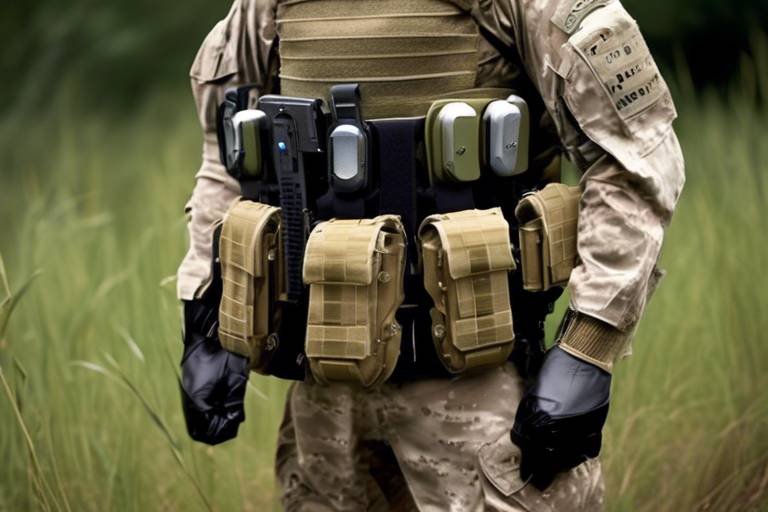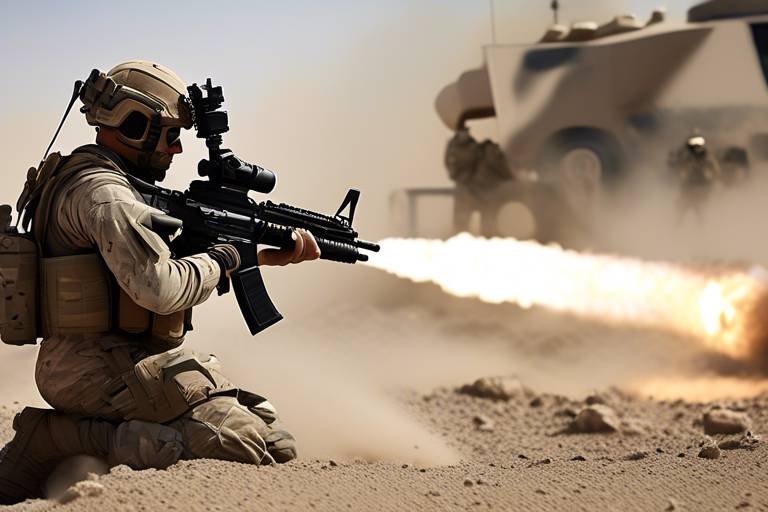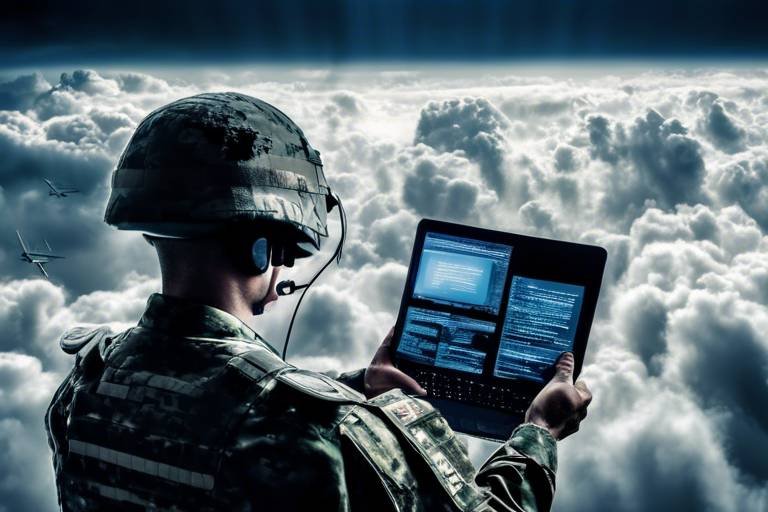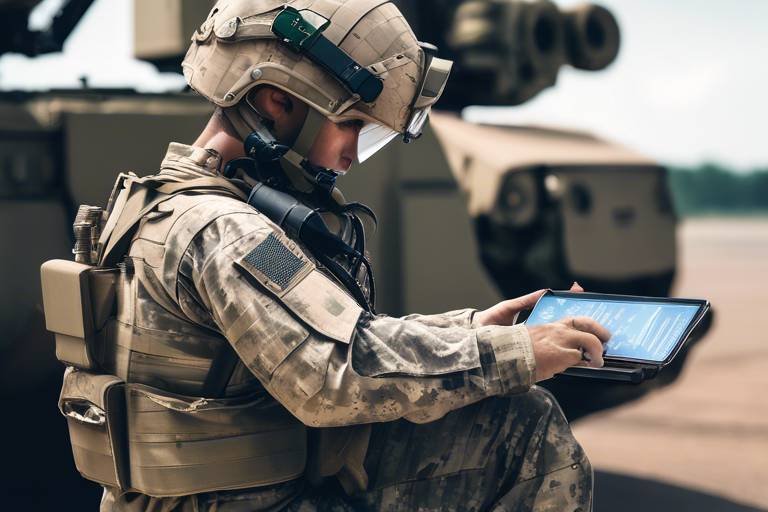How AI is Shaping the Future of Military Logistics
The landscape of military logistics is undergoing a seismic shift, thanks to the advent of artificial intelligence (AI). Imagine a world where supply chains are not just reactive but proactive, where every piece of equipment is tracked with pinpoint accuracy, and where decisions are made in the blink of an eye based on real-time data. This isn't science fiction; it's the new reality that AI is creating within military logistics. As we dive into this transformative journey, we'll uncover how AI is not only enhancing operational efficiency but also redefining the very essence of military readiness.
At its core, military logistics is about ensuring that troops have the right resources at the right time. With the complexities of modern warfare, characterized by rapidly changing environments and unpredictable challenges, traditional logistics methods often fall short. Enter AI—a powerful ally that offers innovative solutions to age-old problems. From optimizing supply chains to predicting maintenance needs, AI is reshaping how armed forces manage their resources.
One of the most exciting aspects of AI in military logistics is its ability to analyze vast amounts of data quickly. This capability allows military leaders to make informed decisions that can mean the difference between mission success and failure. Imagine trying to navigate a maze blindfolded; AI acts as the guide, illuminating the path and revealing potential pitfalls before they become obstacles. As we explore the various dimensions of AI's impact on logistics, it's essential to recognize both the benefits and the challenges that come with this technological evolution.
AI enhances supply chain management by optimizing inventory levels, predicting demand, and improving delivery times, ultimately ensuring that military operations are well-equipped and responsive to dynamic situations. By employing machine learning algorithms, military logistics can analyze historical data to forecast future needs accurately. This predictive capability is crucial in maintaining the right stock levels, preventing shortages, and minimizing waste. For instance, if a particular unit consistently requires more ammunition during certain operations, AI can adjust inventory accordingly, ensuring that troops are always prepared.
Predictive analytics powered by AI can forecast equipment failures, allowing military logistics to implement proactive maintenance strategies, thereby reducing downtime and enhancing operational readiness. Imagine a scenario where a vehicle breaks down in the middle of a critical mission; this can be catastrophic. However, with predictive maintenance, AI can analyze usage patterns and environmental conditions to predict when a piece of equipment is likely to fail. This foresight enables military personnel to perform maintenance before issues arise, keeping operations running smoothly.
Automation in transportation and distribution processes streamlines logistics operations, reducing human error and increasing efficiency in delivering supplies to troops in the field. Drones and autonomous vehicles are becoming increasingly common, capable of transporting essential supplies to remote locations without putting personnel at risk. This not only saves time but also allows human resources to be allocated to more strategic tasks, enhancing overall mission effectiveness.
AI enables data-driven decision-making in military logistics by analyzing vast amounts of information, helping commanders make informed choices about resource allocation and mission planning. By integrating AI tools, military leaders can visualize complex data sets, identify trends, and simulate various scenarios. This analytical power equips them with the insights necessary to optimize logistics strategies and respond effectively to evolving battlefield dynamics.
Despite its potential, the integration of AI in military logistics faces challenges such as data security, resistance to change, and the need for skilled personnel to manage advanced technologies. The military operates in environments where data breaches can have severe consequences, making cybersecurity a top priority. Furthermore, there may be hesitancy among personnel to fully embrace AI technologies, stemming from fears of job displacement or a lack of understanding of how these systems work. Overcoming these hurdles is crucial for realizing the full benefits of AI in logistics.
AI technologies improve situational awareness by providing real-time data analysis, enabling military logistics to respond swiftly to changing conditions on the battlefield. With AI, troops can receive instant updates on supply statuses, weather conditions, and enemy movements, allowing for agile decision-making. This heightened awareness is akin to having a bird’s eye view of the battlefield, where every detail is captured and analyzed to ensure optimal responses to threats.
Examining real-world case studies reveals the practical applications of AI in military logistics, showcasing successful implementations and the lessons learned from these experiences. For example, the U.S. military has utilized AI-driven systems for inventory management, significantly reducing waste and ensuring that critical supplies are available when needed. These case studies not only highlight the effectiveness of AI but also serve as blueprints for future innovations in military logistics.
Looking ahead, the future of AI in military logistics promises further advancements, with emerging technologies likely to revolutionize how armed forces manage resources and conduct operations. As AI continues to evolve, we can expect to see even more sophisticated systems that integrate seamlessly with existing logistics frameworks, enhancing both efficiency and effectiveness in defense operations.
The deployment of AI in military logistics raises ethical considerations, including accountability, transparency, and the implications of autonomous decision-making in combat scenarios. As we embrace these advanced technologies, it is vital to establish guidelines and frameworks that ensure ethical standards are upheld. The conversation around AI in defense is not just about technology; it’s about the responsibilities that come with it.
- What is the primary benefit of AI in military logistics?
AI enhances efficiency and decision-making, ensuring that military personnel have the resources they need when they need them. - Are there any risks associated with AI in military logistics?
Yes, challenges include data security, resistance to change, and ethical concerns regarding autonomous decision-making. - How does predictive maintenance work with AI?
AI analyzes data from equipment usage to predict potential failures, allowing for timely maintenance and reducing downtime.

The Role of AI in Supply Chain Management
In the ever-evolving landscape of military logistics, the integration of artificial intelligence (AI) has emerged as a game-changer, especially in the realm of supply chain management. Imagine a world where military operations are seamlessly equipped with the right resources at the right time—this is the reality that AI is helping to create. By optimizing inventory levels, AI ensures that supplies are not just available but also strategically positioned to respond to dynamic situations on the battlefield.
One of the key advantages of AI in supply chain management is its ability to predict demand. Through sophisticated algorithms and data analysis, AI can forecast the needs of troops based on various factors, including historical data, weather conditions, and even troop movements. This predictive capability is akin to having a crystal ball that enables military planners to anticipate requirements before they arise, ensuring that soldiers are never left wanting for essential supplies.
Furthermore, AI enhances delivery times by optimizing routes and schedules. With the help of real-time data, AI can analyze traffic patterns, weather conditions, and other variables that may affect transportation. This means that logistics personnel can make informed decisions about the best ways to deliver supplies, minimizing delays and ensuring that troops receive what they need when they need it.
To illustrate the impact of AI on supply chain efficiency, consider the following table that summarizes the key benefits of AI integration:
| Benefit | Description |
|---|---|
| Inventory Optimization | Maintains optimal stock levels to prevent shortages or excess. |
| Demand Forecasting | Predicts future supply needs based on data analysis. |
| Improved Delivery Times | Enhances logistics efficiency through optimized routing. |
| Cost Reduction | Minimizes waste and unnecessary expenditures in the supply chain. |
The transformation brought by AI does not stop at inventory and delivery. It extends to the entire logistics ecosystem within military operations. By leveraging AI, military logistics can become more agile, capable of adapting to the unpredictable nature of modern warfare. The traditional supply chain, often bogged down by manual processes and human error, can now be streamlined into a responsive, data-driven machine.
In conclusion, the role of AI in supply chain management is not just about efficiency; it's about creating a robust and resilient logistics framework that can withstand the pressures of military operations. As we embrace these technologies, the potential for enhanced operational readiness and effectiveness becomes not just a possibility but a reality.
- What is the primary benefit of AI in military supply chain management?
AI optimizes inventory levels and predicts demand, ensuring timely delivery of supplies. - How does AI improve delivery times?
AI analyzes real-time data to optimize routes and schedules, reducing delays in supply delivery. - Can AI help in cost reduction within military logistics?
Yes, AI minimizes waste and unnecessary expenditures by improving efficiency and accuracy in the supply chain.

Predictive Analytics for Maintenance
Imagine a world where military equipment never breaks down unexpectedly, where every tank, aircraft, and piece of machinery is always ready for action. This is not just a dream; it’s becoming a reality thanks to predictive analytics powered by artificial intelligence. By analyzing vast amounts of data from various sources, AI can forecast potential equipment failures before they occur. This proactive approach allows military logistics to implement maintenance strategies that significantly reduce downtime, ensuring that operational readiness is always at its peak.
At the heart of predictive analytics is the ability to collect and analyze data from multiple sensors embedded in military equipment. These sensors monitor everything from engine temperature to vibration levels, providing a continuous stream of information. By applying advanced algorithms, AI can identify patterns and anomalies that may indicate an impending failure. For example, if a helicopter's rotor system shows unusual vibration patterns, the system can alert maintenance crews to investigate before a catastrophic failure occurs.
This approach not only enhances the reliability of military assets but also optimizes maintenance schedules. Instead of relying on a reactive maintenance model, where repairs are made only after a failure, predictive analytics shifts the focus to a more proactive strategy. This means that maintenance can be scheduled during downtime, minimizing disruption to operations. The result? Increased efficiency and a more effective military force.
Moreover, predictive analytics can help in resource allocation. By understanding which equipment is likely to need maintenance soon, military logistics can ensure that spare parts and technicians are available when needed. This level of foresight is crucial in combat situations where every minute counts. Imagine a scenario where a critical piece of equipment is out of commission due to a preventable failure—this could have dire consequences on the battlefield.
To illustrate the impact of predictive analytics, consider the following table that outlines the benefits of implementing such systems in military logistics:
| Benefit | Description |
|---|---|
| Reduced Downtime | Proactive maintenance prevents unexpected failures, keeping equipment operational. |
| Cost Savings | Less emergency repairs and better resource allocation lead to significant cost reductions. |
| Enhanced Readiness | Always having equipment ready increases the effectiveness of military operations. |
| Data-Driven Insights | Real-time data helps in making informed decisions regarding maintenance and logistics. |
In conclusion, the integration of predictive analytics in military maintenance is a game-changer. It not only enhances the operational readiness of military forces but also ensures that resources are utilized efficiently. As technology continues to advance, we can expect even greater improvements in how military logistics manage maintenance, leading to a more effective and responsive defense system.
- What is predictive analytics? Predictive analytics involves using statistical algorithms and machine learning techniques to identify the likelihood of future outcomes based on historical data.
- How does AI improve military maintenance? AI analyzes data from equipment sensors to predict failures, allowing for proactive maintenance and reducing unexpected downtime.
- What are the benefits of using predictive analytics in military logistics? Benefits include reduced downtime, cost savings, enhanced readiness, and data-driven insights for better decision-making.
- Can predictive analytics be applied to other industries? Yes, predictive analytics is widely used in various industries, including healthcare, manufacturing, and transportation, to improve efficiency and reduce costs.

Automating Transportation and Distribution
In the world of military logistics, automation is becoming a game-changer, particularly in the realms of transportation and distribution. Imagine a scenario where supplies are delivered to troops in the field not just accurately, but also at lightning speed. This is not a distant dream; it’s happening right now thanks to advancements in artificial intelligence (AI). By automating these processes, the military can significantly reduce human error, streamline operations, and enhance overall efficiency.
One of the most significant benefits of automation in transportation is the ability to utilize autonomous vehicles. These vehicles can navigate complex terrains, deliver supplies, and even return to base without human intervention. This not only minimizes the risk to personnel but also ensures that essential supplies reach their destination quickly and reliably. For instance, consider the use of unmanned aerial vehicles (UAVs) for transporting medical supplies to remote locations. In emergencies, every second counts, and UAVs can bypass traditional roadblocks, delivering critical aid in record time.
Moreover, automation helps in the meticulous planning and scheduling of transport routes. AI algorithms can analyze various factors such as traffic patterns, weather conditions, and even the status of enemy forces to determine the most efficient routes for supply convoys. This data-driven approach ensures that resources are utilized effectively, reducing waste and optimizing delivery times. Here’s a quick look at how automation can transform transportation logistics:
| Benefits of Automation | Impact on Military Logistics |
|---|---|
| Reduced Human Error | Minimizes mistakes in supply delivery and tracking. |
| Increased Efficiency | Faster delivery times and optimized resource allocation. |
| Enhanced Safety | Reduces risk to personnel by minimizing their presence in dangerous areas. |
| Data-Driven Decisions | Improves planning and operational effectiveness through real-time data analysis. |
Furthermore, automation isn’t just about vehicles; it extends to the entire logistics chain. Smart warehousing solutions, powered by AI, can manage inventory levels, predict stock shortages, and automate reordering processes. This ensures that the right supplies are always available, ready to be dispatched at a moment's notice. With AI-enabled systems, the military can maintain a just-in-time inventory, reducing storage costs and ensuring that resources are not just available but are also efficiently managed.
However, the transition to automated systems is not without its challenges. There are concerns about data security and the potential for cyberattacks on automated vehicles and logistics systems. Additionally, there is a need for skilled personnel who can manage and troubleshoot these advanced technologies. As we look to the future, the integration of automation in military logistics will require a careful balance between embracing innovation and addressing these critical challenges.
- What are the main benefits of automating military logistics?
Automation reduces human error, increases efficiency, enhances safety, and facilitates data-driven decision-making. - How do autonomous vehicles improve logistics?
They can navigate complex terrains and deliver supplies without human intervention, minimizing risks and ensuring timely delivery. - What challenges does automation face in military logistics?
Key challenges include data security concerns, the need for skilled personnel, and resistance to change within military operations.

Data-Driven Decision Making
In today's fast-paced military environment, has become a cornerstone of effective logistics management. Imagine being a commander in the heat of battle, where every second counts, and the right decision can mean the difference between success and failure. This is where artificial intelligence (AI) steps in, transforming the way military leaders analyze information and make critical choices. By harnessing the power of AI, military logistics can now process vast amounts of data in real-time, allowing for informed decisions that enhance operational efficiency.
One of the most significant advantages of AI in military logistics is its ability to analyze complex datasets quickly and accurately. This includes everything from troop movements and supply levels to environmental conditions and enemy activities. By utilizing advanced algorithms and machine learning techniques, AI can identify patterns and trends that would be nearly impossible for humans to detect in such a short timeframe. This capability enables commanders to allocate resources effectively, ensuring that troops have what they need when they need it, even in the most unpredictable situations.
Furthermore, AI-driven analytics can simulate various scenarios based on historical data and current conditions. This predictive capability allows military leaders to anticipate potential challenges and develop contingency plans before they arise. For example, if data suggests a potential shortage of ammunition in a specific region, logistics teams can proactively redistribute supplies from less critical areas. This kind of foresight is invaluable on the battlefield, where adaptability and speed are paramount.
To illustrate the impact of data-driven decision making, consider the following table showcasing key benefits of AI integration in military logistics:
| Benefit | Description |
|---|---|
| Improved Resource Allocation | AI analyzes data to optimize the distribution of supplies and personnel. |
| Enhanced Operational Readiness | Real-time data allows for quick adjustments to logistics plans, ensuring troops are always prepared. |
| Increased Efficiency | Streamlined processes reduce waste and ensure timely delivery of essential supplies. |
| Better Risk Management | AI can predict potential issues, allowing for proactive measures to mitigate risks. |
However, while the benefits are substantial, it's essential to acknowledge the challenges that come with data-driven decision making. The sheer volume of data generated can be overwhelming, and without the right tools and training, military personnel may struggle to extract actionable insights. Additionally, data quality is paramount; inaccurate or outdated information can lead to disastrous decisions. Therefore, investing in robust data management systems and ongoing training for personnel is crucial to harnessing the full potential of AI in military logistics.
In conclusion, the integration of AI into military logistics is revolutionizing data-driven decision making, providing commanders with the tools they need to make informed choices quickly. As technology continues to evolve, the potential for even greater advancements in logistics management is on the horizon. With the right approach, military forces can leverage AI to enhance their operational capabilities and ultimately achieve greater success on the battlefield.
- What is data-driven decision making in military logistics?
Data-driven decision making involves using data analytics and AI to inform logistics strategies, ensuring that resources are allocated efficiently and effectively.
- How does AI improve military logistics?
AI enhances military logistics by analyzing large datasets, predicting supply needs, and optimizing resource distribution in real-time.
- What challenges are associated with implementing AI in military logistics?
Challenges include data security, the need for skilled personnel, and ensuring data quality to avoid making decisions based on inaccurate information.

Challenges of Implementing AI
Implementing artificial intelligence in military logistics is not as straightforward as it might seem. While the potential benefits are enormous, there are several significant challenges that organizations face when trying to integrate AI into their operations. One major hurdle is data security. With the increasing reliance on AI, the amount of data being generated and processed has skyrocketed. This influx of information is a double-edged sword; while it can enhance decision-making, it also creates vulnerabilities. Cybersecurity threats loom large, and protecting sensitive military data from breaches is paramount.
Another challenge is the resistance to change that often accompanies the introduction of new technologies. Military personnel and logistics managers may be accustomed to traditional methods of operation. Convincing them to embrace AI-driven solutions requires not only demonstrating the benefits but also providing comprehensive training. The transition can feel like trying to teach an old dog new tricks—it's not impossible, but it demands patience and persistence.
Moreover, the need for skilled personnel to manage and operate these advanced technologies cannot be overlooked. AI systems are complex and require a workforce that is not only trained in the technology itself but also understands the unique demands of military logistics. This creates a gap between the existing workforce and the skills required for effective AI implementation. Organizations must invest in training programs and possibly even recruit new talent, which can be both time-consuming and costly.
Additionally, the integration of AI into military logistics raises questions about accountability and transparency. When decisions are made by algorithms, who is responsible for the outcomes? This uncertainty can create hesitation among military leaders to fully trust AI systems, especially in high-stakes environments where lives are on the line. Establishing clear guidelines and frameworks for accountability is essential to foster confidence in AI technologies.
In summary, while AI has the potential to revolutionize military logistics, the challenges of data security, resistance to change, skilled personnel shortages, and accountability must be addressed. Overcoming these obstacles will require a concerted effort from military organizations, stakeholders, and technology providers. Only then can the full benefits of AI be realized in enhancing efficiency and effectiveness in defense operations.
- What are the primary challenges of implementing AI in military logistics?
Data security, resistance to change, the need for skilled personnel, and accountability are the main challenges faced. - How can military organizations overcome resistance to change?
By providing comprehensive training and demonstrating the benefits of AI technologies. - Why is data security a concern with AI?
The increased reliance on AI leads to the generation of vast amounts of sensitive data, making it a target for cyber threats. - What role does accountability play in AI implementation?
Establishing clear guidelines for accountability is crucial when algorithms make decisions that impact military operations.

Enhancing Situational Awareness
In the fast-paced world of military operations, situational awareness is crucial. It’s like having a radar that not only detects incoming threats but also provides a comprehensive understanding of the battlefield landscape. With the integration of artificial intelligence, this capability has been significantly enhanced, allowing military personnel to make informed decisions quickly and efficiently. Imagine being in a high-stakes game of chess, where every move counts, and having a super-intelligent assistant that predicts your opponent's strategies—that’s what AI brings to the table in military logistics.
AI technologies analyze vast amounts of data from various sources, such as satellite imagery, drones, and ground sensors. This data is then processed in real-time, enabling commanders to visualize the battlefield and anticipate changes in enemy movements or environmental conditions. For instance, AI can track troop movements and supply levels, providing a holistic view that is essential for effective resource management. It’s like having a bird's-eye view of the entire operation, where every piece of information is interconnected and easily accessible.
Moreover, AI-driven systems can prioritize information based on urgency and relevance, which is vital during critical operations. For example, if a sudden weather change threatens a supply route, AI can alert logistics teams to reroute supplies efficiently, ensuring that troops receive what they need without delay. This proactive approach not only saves time but also enhances the overall effectiveness of military missions.
Another fascinating aspect of AI in enhancing situational awareness is its ability to predict potential threats. By leveraging machine learning algorithms, AI can identify patterns in data that human analysts might overlook. This predictive capability allows military planners to foresee and mitigate risks before they escalate. Imagine being able to foresee a potential ambush or a supply chain disruption before it happens—this is the power of AI.
However, while AI significantly boosts situational awareness, it’s important to remember that it is not a magic bullet. The effectiveness of these systems relies heavily on the quality of data input and the human expertise that interprets the results. Therefore, training personnel to work alongside AI technologies is essential. They need to understand how to leverage these tools to enhance their decision-making processes. After all, AI is like a powerful engine; without a skilled driver, it can lead to chaos instead of order.
In summary, the enhancement of situational awareness through AI is a game-changer for military logistics. By providing real-time data analysis, predictive insights, and a comprehensive battlefield view, AI empowers military leaders to make informed decisions swiftly. As technology continues to evolve, the potential for AI to further revolutionize situational awareness in military operations is immense. The future is bright, and with it comes the promise of a more efficient and responsive military logistics framework.
- What is situational awareness in military logistics?
Situational awareness refers to the ability to perceive and understand the current environment and make informed decisions based on that understanding. In military logistics, it involves tracking resources, enemy movements, and environmental conditions. - How does AI improve situational awareness?
AI enhances situational awareness by analyzing large datasets in real-time, predicting potential threats, and providing commanders with actionable insights that help them make timely decisions. - What are the challenges of using AI in military logistics?
Challenges include data security concerns, the need for skilled personnel to manage AI systems, and resistance to change within military organizations. - Can AI replace human decision-making in military operations?
While AI can provide valuable insights and predictions, human expertise remains crucial in interpreting data and making final decisions, especially in complex and unpredictable situations.
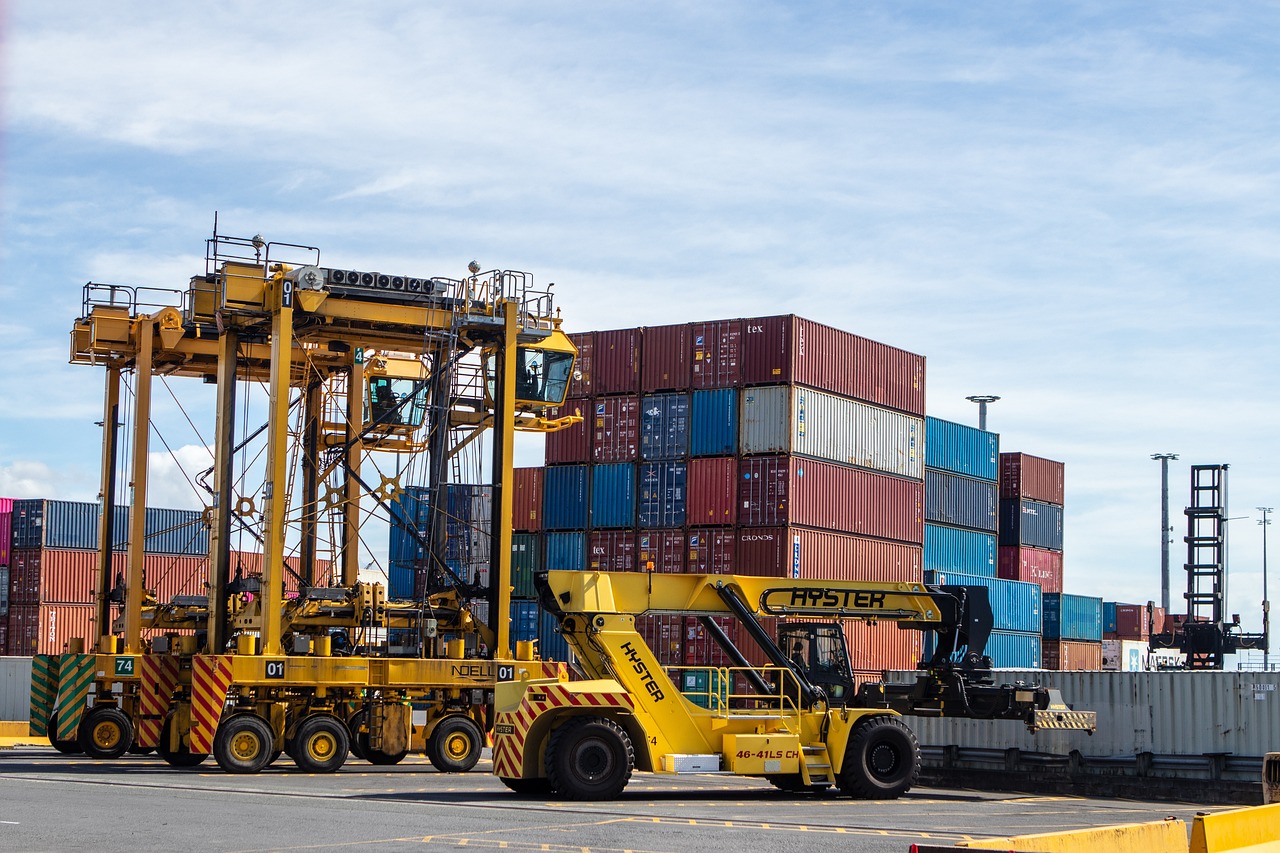
Case Studies of AI in Military Logistics
When it comes to the integration of artificial intelligence in military logistics, real-world examples provide invaluable insights into its practical applications and effectiveness. One notable case study is the U.S. Army's use of AI for predictive maintenance. By utilizing machine learning algorithms, the Army has significantly improved its equipment uptime. This is achieved by analyzing historical data and identifying patterns that indicate when maintenance should be performed. The result? A remarkable reduction in unexpected equipment failures, which ultimately enhances operational readiness and effectiveness on the battlefield.
Another compelling example comes from the British Army, which has implemented AI-driven logistics planning tools. These tools leverage vast amounts of data to optimize supply chain routes and inventory management. By predicting demand and adjusting supply levels accordingly, the Army can ensure that troops have the necessary resources at the right time and place. This not only streamlines operations but also minimizes waste and reduces costs, showcasing how AI can transform traditional logistics practices into more efficient systems.
Furthermore, the Israeli Defense Forces (IDF) have adopted AI technologies to enhance their situational awareness. Through the integration of AI with their existing logistics systems, the IDF can analyze real-time data from various sources, including drones and satellite imagery. This capability allows for swift adjustments in logistics operations, ensuring that supplies are delivered precisely when and where they are needed, even in rapidly changing battlefield conditions. The ability to adapt logistics in real-time can be likened to a chess player anticipating their opponent's moves, ensuring that the supply chain remains agile and responsive.
These case studies illustrate not only the benefits of AI in military logistics but also the transformative potential it holds for future operations. However, they also highlight the importance of addressing challenges such as data security and the need for skilled personnel to manage these advanced systems. As military organizations continue to embrace AI, the lessons learned from these implementations will be crucial in shaping the future of defense logistics.
- What are the main benefits of using AI in military logistics? AI enhances efficiency, reduces downtime, improves supply chain management, and enables predictive maintenance.
- What challenges do military organizations face when integrating AI? Key challenges include data security, resistance to change, and the need for personnel skilled in advanced technologies.
- How does AI improve situational awareness in military logistics? AI analyzes real-time data from various sources, allowing for quick adjustments in logistics operations based on current battlefield conditions.
- Can AI completely replace human decision-making in military logistics? While AI can assist in decision-making, human oversight remains crucial for accountability and ethical considerations.

The Future of AI in Defense
As we peer into the horizon of military logistics, it's clear that the future of AI in defense is not just a fleeting trend; it's a profound transformation that could redefine how armed forces operate. Imagine a world where logistics are so seamless that supplies are delivered to troops just as they need them, without delay. This vision is becoming more tangible as AI technologies evolve, promising to enhance efficiency, effectiveness, and adaptability in defense operations.
One of the most striking advancements is the integration of autonomous systems. These systems, powered by AI, can operate without direct human intervention, whether it's drones delivering medical supplies to remote locations or automated vehicles transporting munitions to the front lines. This autonomy not only speeds up the logistics process but also minimizes risks to personnel in dangerous environments. In fact, the military is already experimenting with unmanned aerial vehicles (UAVs) and ground robots that can navigate complex terrains and deliver essential resources.
Moreover, the future holds exciting possibilities for machine learning algorithms that can analyze patterns in logistics data. By identifying trends and predicting future needs, these algorithms can help military planners allocate resources more effectively. For instance, if a particular unit frequently requires medical supplies during specific operations, AI can ensure that these resources are pre-positioned, reducing response times and enhancing operational readiness.
Another key aspect of AI's future in defense is its role in enhancing collaboration across different military branches and allied forces. With AI-driven platforms, data can be shared in real-time, allowing for synchronized operations that are crucial in modern warfare. Imagine a situation where the Army, Navy, and Air Force are all on the same page, thanks to AI facilitating communication and logistics management. This level of coordination could be a game-changer in joint operations.
However, as we embrace these advancements, it’s essential to consider the ethical implications of deploying AI in military contexts. Questions around accountability and transparency become paramount, especially as autonomous systems make decisions that could impact human lives. Striking a balance between leveraging AI for operational efficiency and ensuring ethical standards will be critical as we move forward.
To sum it up, the future of AI in defense is brimming with potential. From autonomous logistics systems to data-driven decision-making, the possibilities are endless. As military forces around the globe continue to invest in these technologies, we can expect a revolution in how they manage resources and conduct operations. The key will be to harness these innovations responsibly, ensuring that they enhance our capabilities without compromising our values.
- What are the main benefits of AI in military logistics? AI enhances efficiency, reduces response times, and improves resource allocation.
- How does AI improve decision-making in defense? AI analyzes vast amounts of data to provide insights that help commanders make informed choices.
- What ethical concerns are associated with AI in defense? Key concerns include accountability, transparency, and the implications of autonomous decision-making.
- Will AI replace human roles in military logistics? While AI will automate certain tasks, human oversight will remain crucial for decision-making and ethical considerations.

Ethical Considerations in AI Deployment
As we delve into the realm of artificial intelligence in military logistics, we can't ignore the ethical considerations that come into play. The integration of AI into defense operations is not just a matter of efficiency and effectiveness; it raises profound questions about accountability, transparency, and the moral implications of machines making critical decisions in combat scenarios. Imagine a battlefield where algorithms, not humans, determine the fate of lives. It’s a thought that can send shivers down anyone's spine.
One of the primary concerns is accountability. If an AI system makes a decision that leads to unintended consequences—like collateral damage or misallocation of resources—who is responsible? Is it the programmers, the military leaders, or the machine itself? This ambiguity can create a legal and moral quagmire. As we advance towards a future where AI plays a pivotal role, establishing clear lines of accountability becomes essential. The question remains: can we hold a machine accountable, or is it merely a tool, devoid of moral responsibility?
Another crucial aspect is transparency. AI systems often operate as "black boxes," where the decision-making process is not easily understood, even by their creators. This lack of transparency can lead to mistrust among military personnel and the public. When decisions are made without clear explanations, it can breed skepticism and fear. For instance, if a drone strike is initiated based on AI analysis, how can we ensure that the data used was reliable and that the decision-making process was sound? To foster trust, there must be an emphasis on developing AI systems that are not only effective but also interpretable.
Moreover, the use of AI in military logistics invokes a discussion about autonomous decision-making. In scenarios where AI systems are tasked with making life-and-death decisions in real-time, we face the ethical dilemma of whether machines should have the authority to act independently. This brings us to the concept of human oversight. Many argue that while AI can assist in logistics and decision-making, the final call should always rest with a human operator. This hybrid approach could mitigate risks while leveraging the strengths of both AI and human judgment.
To further illustrate these points, consider the following table that summarizes the key ethical concerns associated with AI deployment in military logistics:
| Ethical Concern | Description |
|---|---|
| Accountability | Determining who is responsible for AI-driven decisions and their consequences. |
| Transparency | The need for clear understanding of how AI systems make decisions. |
| Autonomous Decision-Making | Debating whether machines should act independently in critical situations. |
| Human Oversight | The importance of retaining human control over AI systems. |
As we continue to explore the integration of AI into military logistics, it’s crucial to engage in open discussions about these ethical considerations. The path forward must involve collaboration between technologists, military leaders, ethicists, and the public to ensure that we harness the power of AI responsibly and ethically.
- What are the main ethical concerns regarding AI in military logistics? The main concerns include accountability, transparency, autonomous decision-making, and the necessity for human oversight.
- How can we ensure accountability in AI-driven military decisions? Establishing clear lines of responsibility and legal frameworks is essential to address accountability issues.
- Why is transparency important in AI systems? Transparency fosters trust and enables stakeholders to understand the decision-making processes of AI systems.
- Should AI have the authority to make autonomous decisions in combat? This is a contentious issue, with many advocating for human oversight to mitigate risks associated with autonomous actions.
Frequently Asked Questions
-
How does AI improve military logistics?
AI enhances military logistics by optimizing supply chain management, predicting demand, and improving delivery times. This means that troops get the supplies they need when they need them, which is crucial for operational success.
-
What is predictive analytics in military logistics?
Predictive analytics involves using AI to forecast equipment failures before they happen. By analyzing data, military logistics can implement proactive maintenance strategies, reducing downtime and ensuring that equipment is always ready for action.
-
Can AI automate transportation in military logistics?
Absolutely! AI can automate various aspects of transportation and distribution, streamlining operations and minimizing human error. This leads to faster and more efficient delivery of supplies to troops in the field.
-
What role does data-driven decision-making play in military logistics?
Data-driven decision-making allows commanders to analyze vast amounts of information to make informed choices about resource allocation and mission planning. This ensures that every decision is backed by solid data, improving overall effectiveness.
-
What challenges does AI face in military logistics?
While AI has great potential, its integration into military logistics comes with challenges like data security concerns, resistance to change from personnel, and the necessity for skilled individuals who can manage these advanced technologies.
-
How does AI enhance situational awareness?
AI technologies improve situational awareness by providing real-time data analysis. This allows military logistics to respond quickly to changing battlefield conditions, which can be the difference between success and failure in operations.
-
Are there any real-world examples of AI in military logistics?
Yes! There are numerous case studies showcasing the practical applications of AI in military logistics. These examples highlight successful implementations and the valuable lessons learned from them, demonstrating AI's transformative impact.
-
What does the future hold for AI in military logistics?
The future of AI in military logistics looks promising, with emerging technologies set to revolutionize resource management and operational strategies. Expect to see even more advanced applications that enhance efficiency and effectiveness in defense operations.
-
What ethical considerations are there with AI in military logistics?
The deployment of AI raises important ethical questions regarding accountability, transparency, and the implications of autonomous decision-making in combat scenarios. These considerations are crucial to ensure responsible use of AI technologies.




